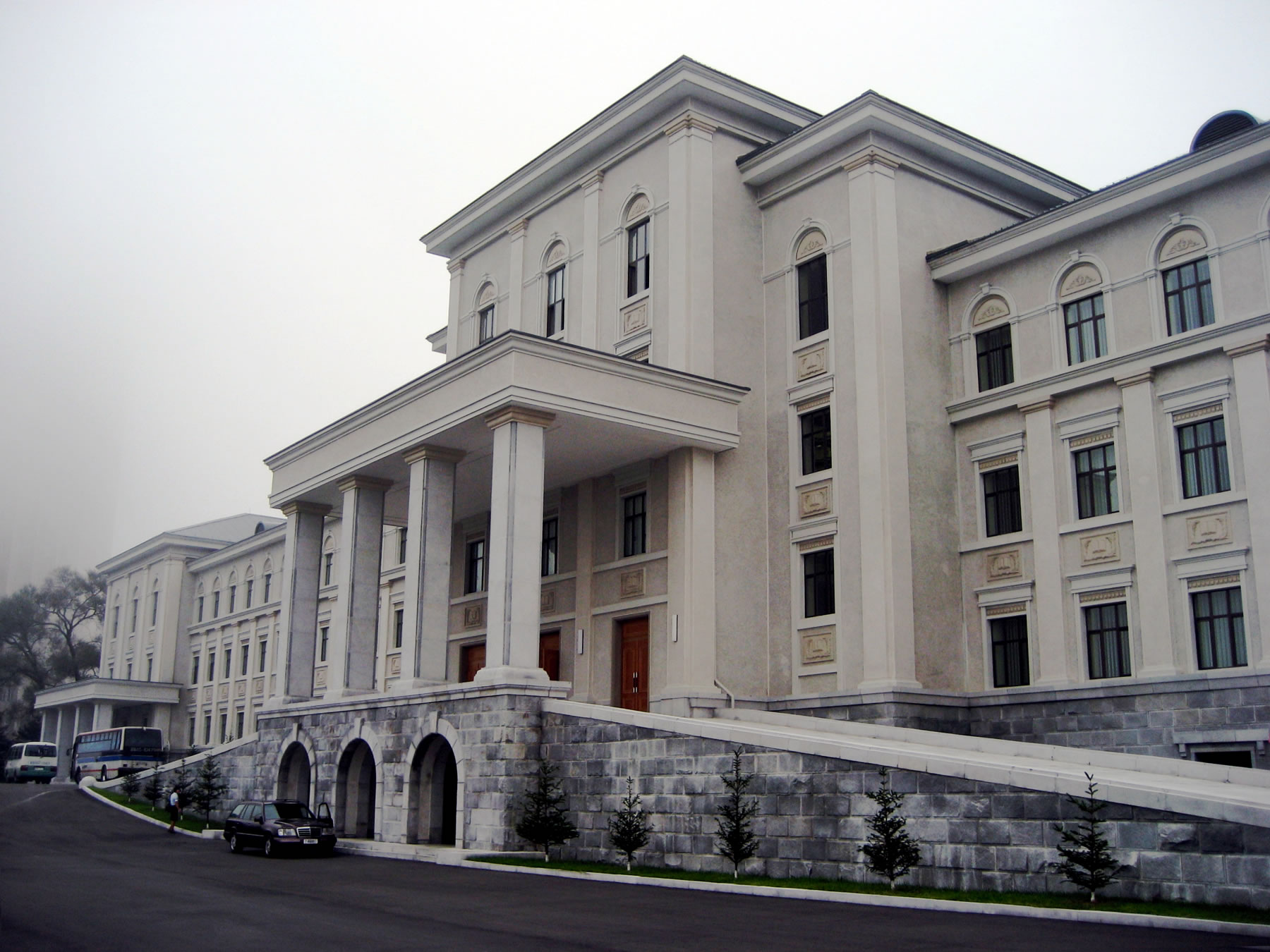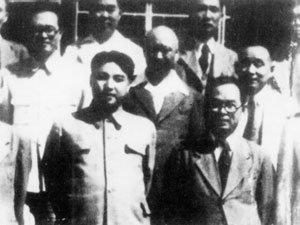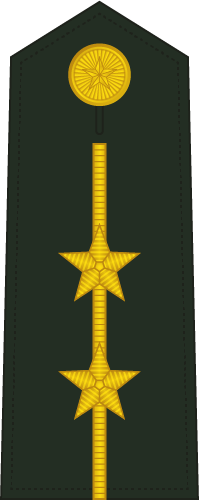|
Kim Il-sung University Of Politics
The Kim Il-sung University of Politics (Korean: 김일성정치대학), also known as the Kim Il-sung Political University, is a university for the training of political officers in the Korean People's Army located in Hyongjesan-guyok, Pyongyang, North Korea. History The university traces its roots to the political officers class of the Pyongyang Institute (Korean: 평양학원) that was established on 17 November 1945 and was initially located in Nampo. The political officers class was split from the institute in May 1947 to form the Second Military Officers School (Korean: 제2군관학교) and was relocated to Pyongyang. The school was renamed in February 1952 as the Kim Chaek Political Officers School (Korean: 김책군관학교) and finally received its current name in February 1972. Curriculum It offers a four-year political officer training course for enlisted soldiers who have served for at least three years and for non-commissioned officers. Graduates of this course ... [...More Info...] [...Related Items...] OR: [Wikipedia] [Google] [Baidu] |
Pyongyang
Pyongyang (, , ) is the capital and largest city of North Korea, where it is known as the "Capital of the Revolution". Pyongyang is located on the Taedong River about upstream from its mouth on the Yellow Sea. According to the 2008 population census, it has a population of 3,255,288. Pyongyang is a directly administered city () with equal status to North Korean provinces. Pyongyang is one of the oldest cities in Korea. It was the capital of two ancient Korean kingdoms, Gojoseon and Goguryeo, and served as the secondary capital of Goryeo. Much of the city was destroyed during the First Sino-Japanese War, but it was revived under Japanese rule and became an industrial center. Following the establishment of North Korea in 1948, Pyongyang became its ''de facto'' capital. The city was again devastated during the Korean War, but was quickly rebuilt after the war with Soviet assistance. Pyongyang is the political, industrial and transport center of North Korea. It is home ... [...More Info...] [...Related Items...] OR: [Wikipedia] [Google] [Baidu] |
Juche Idea
''Juche'' ( ; ), officially the ''Juche'' idea (), is the state ideology of North Korea and the official ideology of the Workers' Party of Korea. North Korean sources attribute its conceptualization to Kim Il-sung, the country's founder and first leader. ''Juche'' was originally regarded as a variant of Marxism–Leninism until Kim Jong-il, Kim Il-sung's son and successor, declared it a distinct ideology in the 1970s. Kim Jong-il further developed ''Juche'' in the 1980s and 1990s by making ideological breaks from Marxism–Leninism and increasing the importance of his father's ideas. ''Juche'' incorporates the historical materialist ideas of Marxism–Leninism but also strongly emphasizes the individual, the nation state, and national sovereignty. ''Juche'' posits that a country will prosper once it has become self-reliant by achieving political, economic, and military independence. As Kim Jong-il emerged as Kim Il-sung's likely successor in the 1970s, loyalty to the leade ... [...More Info...] [...Related Items...] OR: [Wikipedia] [Google] [Baidu] |
Universities And Colleges Established In 1945
A university () is an institution of higher (or tertiary) education and research which awards academic degrees in several academic disciplines. Universities typically offer both undergraduate and postgraduate programs. In the United States, the designation is reserved for colleges that have a graduate school. The word ''university'' is derived from the Latin ''universitas magistrorum et scholarium'', which roughly means "community of teachers and scholars". The first universities were created in Europe by Catholic Church monks. The University of Bologna (''Università di Bologna''), founded in 1088, is the first university in the sense of: *Being a high degree-awarding institute. *Having independence from the ecclesiastic schools, although conducted by both clergy and non-clergy. *Using the word ''universitas'' (which was coined at its foundation). *Issuing secular and non-secular degrees: grammar, rhetoric, logic, theology, canon law, notarial law.Hunt Janin: "The university i ... [...More Info...] [...Related Items...] OR: [Wikipedia] [Google] [Baidu] |
Buildings And Structures In Pyongyang
A building, or edifice, is an enclosed structure with a roof and walls standing more or less permanently in one place, such as a house or factory (although there's also portable buildings). Buildings come in a variety of sizes, shapes, and functions, and have been adapted throughout history for a wide number of factors, from building materials available, to weather conditions, land prices, ground conditions, specific uses, prestige, and aesthetic reasons. To better understand the term ''building'' compare the list of nonbuilding structures. Buildings serve several societal needs – primarily as shelter from weather, security, living space, privacy, to store belongings, and to comfortably live and work. A building as a shelter represents a physical division of the human habitat (a place of comfort and safety) and the ''outside'' (a place that at times may be harsh and harmful). Ever since the first cave paintings, buildings have also become objects or canvasses of much artistic ... [...More Info...] [...Related Items...] OR: [Wikipedia] [Google] [Baidu] |
Education In Pyongyang
Education is a purposeful activity directed at achieving certain aims, such as transmitting knowledge or fostering skills and character traits. These aims may include the development of understanding, rationality, kindness, and honesty. Various researchers emphasize the role of critical thinking in order to distinguish education from indoctrination. Some theorists require that education results in an improvement of the student while others prefer a value-neutral definition of the term. In a slightly different sense, education may also refer, not to the process, but to the product of this process: the mental states and dispositions possessed by educated people. Education originated as the transmission of cultural heritage from one generation to the next. Today, educational goals increasingly encompass new ideas such as the liberation of learners, skills needed for modern society, empathy, and complex vocational skills. Types of education are commonly divided into formal, ... [...More Info...] [...Related Items...] OR: [Wikipedia] [Google] [Baidu] |
Universities In North Korea
There are more than 300 colleges and universities in North Korea.Library of Congress country study see p. 7 for Education and Literacy () Universities and colleges in North Korea are classified into central class and local colleges. Also, they can be classified into social, special, and military colleges. Special colleges were established with the purpose to raise top executives. Students who have just graduated from high school cannot enter special colleges without any experience in industrial or cooperative farm careers. In North Korea, there are only two universities such as and |
Military Academies
A military academy or service academy is an educational institution which prepares candidates for service in the officer corps. It normally provides education in a military environment, the exact definition depending on the country concerned. Three types of academy exist: pre-collegiate-level institutions awarding academic qualifications, university-level institutions awarding bachelor's-degree-level qualifications, and those preparing Officer Cadets for commissioning into the armed services of the state. A naval academy is either a type of military academy (in the broad sense of that term) or is distinguished from one (in the narrow sense). In U.S. usage, the Military, Naval, Coast Guard, and the Air Force Academy serve as military academies under the categorization of service academies in that country. History The first military academies were established in the 18th century to provide future officers for technically specialized corps, such as military engineers and art ... [...More Info...] [...Related Items...] OR: [Wikipedia] [Google] [Baidu] |
Workers' Party Of Korea
The Workers' Party of Korea (WPK) is the founding and sole ruling party of the Democratic People's Republic of Korea, commonly known as North Korea. Founded in 1949 from the merger of the Workers' Party of North Korea and the Workers' Party of South Korea, the WPK is the oldest active party in Korea. It also controls the Korean People's Army, North Korea's armed forces. The WPK is the largest party represented in the Supreme People's Assembly and coexists with two other legal parties making up the Democratic Front for the Reunification of Korea. However, these minor parties are completely subservient to the WPK and must accept the WPK's "leading role" as a condition of their existence. The WPK is banned in South Korea (Republic of Korea) under the National Security Act and is sanctioned by the United Nations, the European Union, Australia, and the United States. Officially, the WPK is a communist party guided by Kimilsungism–Kimjongilism, a synthesis of the ideas of Kim ... [...More Info...] [...Related Items...] OR: [Wikipedia] [Google] [Baidu] |
Chungwi
(; ) is the rank held by company-grade officers in some East Asian militaries. The ranks are used in both the People's Republic of China and the Republic of China on Taiwan, and both North and South Korea. Chinese variant People's Liberation Army The same rank names are used for all services, prefixed by () or (). Republic of China Armed Forces Korean variant North Korea South Korea See also * Jiang (rank) * Xiao (rank) * Ranks of the People's Liberation Army * Ranks of the People's Liberation Army Navy *Ranks of the People's Liberation Army Air Force *Republic of China Armed Forces rank insignia The Military ranks of the Republic of China are the ranks used by the Republic of China Armed Forces. The official military rank names in Traditional Chinese are identical across all different military branches, but their English translations may ... References Military ranks of the People's Republic of China Military of the Republic of China {{italictitle ... [...More Info...] [...Related Items...] OR: [Wikipedia] [Google] [Baidu] |
North Korea
North Korea, officially the Democratic People's Republic of Korea (DPRK), is a country in East Asia. It constitutes the northern half of the Korean Peninsula and shares borders with China and Russia to the north, at the Yalu (Amnok) and Tumen rivers, and South Korea to the south at the Korean Demilitarized Zone. North Korea's border with South Korea is a disputed border as both countries claim the entirety of the Korean Peninsula. The country's western border is formed by the Yellow Sea, while its eastern border is defined by the Sea of Japan. North Korea, like its southern counterpart, claims to be the legitimate government of the entire peninsula and adjacent islands. Pyongyang is the capital and largest city. In 1910, Korea was annexed by the Empire of Japan. In 1945, after the Japanese surrender at the end of World War II, Korea was divided into two zones along the 38th parallel, with the north occupied by the Soviet Union and the south occupied by the Unit ... [...More Info...] [...Related Items...] OR: [Wikipedia] [Google] [Baidu] |
Sowi
(; ) is the rank held by company-grade officers in some East Asian militaries. The ranks are used in both the People's Republic of China and the Republic of China on Taiwan, and both North and South Korea. Chinese variant People's Liberation Army The same rank names are used for all services, prefixed by () or (). Republic of China Armed Forces Korean variant North Korea South Korea See also * Jiang (rank) * Xiao (rank) * Ranks of the People's Liberation Army * Ranks of the People's Liberation Army Navy *Ranks of the People's Liberation Army Air Force *Republic of China Armed Forces rank insignia The Military ranks of the Republic of China are the ranks used by the Republic of China Armed Forces. The official military rank names in Traditional Chinese are identical across all different military branches, but their English translations may ... References Military ranks of the People's Republic of China Military of the Republic of China {{italictitle ... [...More Info...] [...Related Items...] OR: [Wikipedia] [Google] [Baidu] |
Kim Chaek
Kim Chaek (, 14 August 1903 – 31 January 1951) was a North Korean revolutionary, military general, and politician. His real name was Kim Hong-gye (). Life Kim Chaek was born in Sŏngjin, North Hamgyong, Korea, in 1903. He and his family fled to Manchuria after Korea was colonized by Japan. In 1927, Kim joined the Communist Party of China and the Anti-Japanese movement to oppose the Japanese occupation. He was imprisoned for his resistance activities. After his release from prison, Kim joined the Northeast Anti-Japanese United Army in 1935 and fought alongside Kim Il-sung. He fled to the Soviet Union to escape the Japanese conquest of the partisans in 1940. He lived in Khabarovsk where he met with Kim Il-sung and formed the 88th Special Brigade. After the Soviet invasion of Manchuria, he returned to Korea along with the Soviet Army in 1945. On September 9, 1948, the Democratic People’s Republic of Korea was established, Kim became the industry minister and deputy pri ... [...More Info...] [...Related Items...] OR: [Wikipedia] [Google] [Baidu] |









